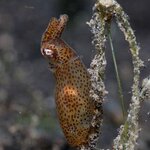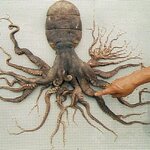Ecology & Zoology

I've mentioned a couple of obscure "squids" here already, the bobtail squid (sepioids, actually more closely related to cuttlefish) and ram's horn squid (spirulids, which form their own evolutionary offshoot of decapods).
Today I am here to rhapsodize about another group that is little in every way--comprising only eight species, about which scant information is known, and which are the smallest squid in the world. By "small" I actually mean "minuscule." Adult pygmy squid can be smaller than your fingernail. Here's Idiosepius pygmaeus:
Is that not cute beyond your wildest dreams? That is,…

If you like big scallops for dinner, we have good news - ocean warming, at least in UK waters, has increased stocks of the great scallop Pecten maximus, according to a study published in Marine Biology.
But further rises in water temperatures could have the opposite effect on scallops and better management of these fisheries may be needed to protect sensitive seabed habitats, according to the analysis of 20 years of data by scientists at Bangor University and the Universities of York and Liverpool.
Dr Bryce Beukers-Stewart, from the University of York's Environment Department, said, "It's…

Wistfully I wish you all a very happy Decapod Day! The Cephalopod Awareness Days have been fun, and I can hardly believe they're coming to an end. Many thanks to Jason of Cephalopodcast for turning this year's celebration into a three-day event!
My own celebrations culminated today with a Humboldt squid dissection at the Monterey Maritime Musuem. It was (entirely coincidentally) the museum's First Annual Squid Day, part of Monterey's History Fest. Squid are an intimate part of the town's history, since market squid have at times been the biggest fishery in the bay (and in all of California).…

On this, the second of the International Cephalopod Appreciation Days, we turn our attention to the pearly nautilus, and "other lesser-known extant and extinct cephalopods."
My favorite is the spirulid, or ram's horn squid. I was introduced to them in Australia, where I kept finding these perfect little white curls in the island beach wrack:
Based on the shell and some library books, I was able to identify it as the single living spirulid species, which bears the poetic name Spirula spirula. I was captivated by the pictures, but I've still never seen one alive.
The shell is…
Today begins the Third Annual International Cephalopod Awareness Days! Naturally, since it is the eighth of the month, we are honoring octopods today. This provides the perfect opening for my favorite cephalo-rant: the etymologically correct plural of octopus.
The rant is prefaced with a quick linguistic detour. Those familiar with declining nouns may skip this paragraph. Anyone who thinks I was talking about nouns becoming forgetful in their old age, please read on. You know how verbs conjugate according to person and tense? I run, you run, he/she/it runs, and so forth? In many languages,…

Chiroteuthids (ky-ro-tooth-ids) are crazy weird squid; their most notable feature is having two sets of fins on the "tail end" of their mantles as paralarvae. To me, this is nearly as bizarre as imagining a whole family of mammals in which babies are born with two sets of hind legs. I imagine cranchiid (cran-kid) squid shouting "hey, four-fins!" as they pass a chiroteuthid in the depths.
(Only technically they aren't four fins:
They all share a very distinctive paralarva known as the doratopsis stage . . . Doratopsis paralarvae and the adult stages of some species have a gladius that extends…

I get some bizarre hits from my google squid alert, like this opinion piece discussing the "Democratic Squid." Squid-A-Day has nothing to say about Chicago, the Olympics, or Obama's foreign policy, but at least I can set the record straight on biology:
A squid had[sic] eight arms and two tentacles plus the ability to inject an inky substance to permeate the water and hide itself. Its skin changes color to suit its environment. It maintains the highest survival intelligence among invertebrates. It has the biggest eyes in the animal kingdom; chop off a tentacle and it can grow a new one. Chop…

My personal favorite sepiolid is the striped pyjama squid. It burrow in the sand! It secretes mucus! And it is spelled in the British way! Seriously, nothing should be allowed to be that cute:
As a bonus, its eyes are closed in this picture, to minimize potential creepiness.
A couple of years ago, during one of these flurries of Humboldt squid activity in the Pacific Northwest, people were reporting headless squid bodies on the beach. It turned out that at least one and possibly several local wolves had caught on to the protein bonanza, and were carrying squid heads home for a calamari feast.
Fun squid fact: squid heads are generally not very well attached to their bodies, so if you grab the head and pull, you'll often leave the body behind. This is probably what was happening to the wolves, and they weren't motivated enough to come back for the bodies.
This…
A biologist friend of mine recently heard from a journalist who was fact-checking a squid article. (Go, conscientious journalism!) The article included the line "the Humboldt squid is five feet long from beak to tentacle tip" and the journalist wanted to know: Is that right, or it would be more correct to say six feet long?
The biologist in question was left wondering if the writer had ever, you know, looked at a squid and considered how one might want to measure it:
Although, all snark aside, most people do not have to consider such challenges on a regular basis. I suggested to the biologist…